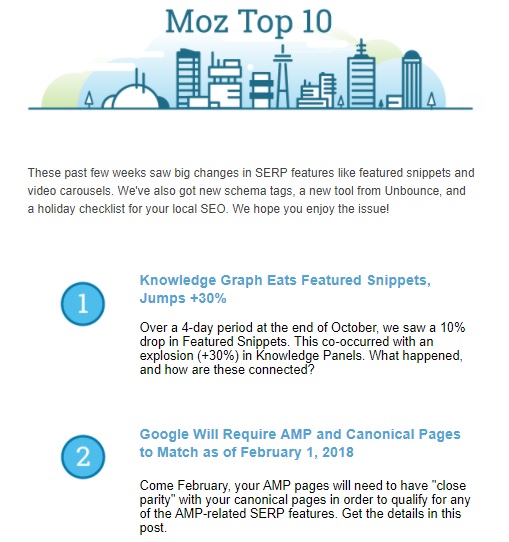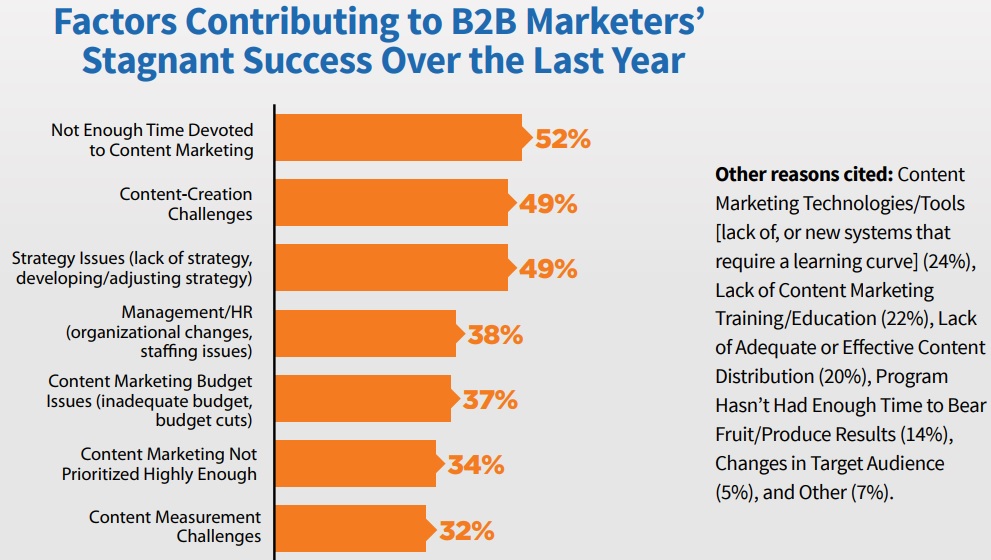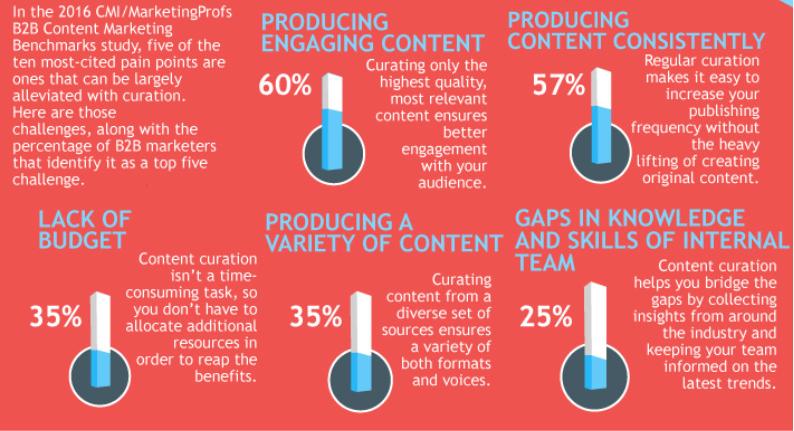Low on budget, short on time but still needing to churn out insightful content to your readers?
Incorporate content curation into your marketing strategy.
Here’s why.
Curated blogs, newsletters and industry updates are valuable complements to a content marketing machine that’s hamstrung by limited resources. Or, if your company is looking to add a different, external perspective to your marketing, curation can be a relevant, cost-effective tool to utilize.
In 2018, it doesn’t have to be content curation versus content creation: It can be both.
What is content curation?
Content curation is the process of gathering highly relevant information from outside sources and sharing it with readers.
For companies in the SaaS space, news on updated customer privacy standards, for instance, would be pertinent to your customers. In the Braftisphere, insights from the Content Marketing Institute or Search Engine Journal are of great value, and so we share that content with our readers (The Content Marketing Weekly).
It’s not created from scratch and it’s not necessarily revolutionary, but it’s relevant and it serves audience intent. The key is that whatever you share needs to be of high quality.
High-quality content that resonates
It’s not enough to gather trustworthy sources and share the opinions of influencers; you also need to ensure that what you’re curating and promoting meaningfully adds to the conversation and presents information in a way that isn’t offered elsewhere.
And you don’t have to rely on articles alone.
Content curation is often seen in three forms:
Email newsletters
Email marketing is a primary vehicle for content marketers to generate leads and deliver quality content directly to the inboxes of high-value prospects.
Leveraging the power of email automation platforms and curated newsletters creates a dynamic and efficient tool that every marketer should use.
One reason they work so well is that you save your subscribers time. Instead of them scouring the internet for hot takes and trendworthy news, all they have to do is open an email: Your newsletter is right there waiting.

Blogs
So what do you put into those newsletters? Many times they’re filled with quality blogs (in addition to downloadable assets like eBooks or visual content like infographics or video).
Curated blogs are great mechanisms to keep blog pages updated and relevant. These articles should feature industry roundups, game-changing business developments and predictions for the future, among others. Essentially, if it can make readers’ lives easier, include it.
Here’s an example of our work, The Content Marketing Weekly:

Social media posts
Posting on various social platforms several times a day likewise benefits from automation and a bit of planning. You’re not always going to have newly created content to share, so curated posts, images, quizzes, data, etc. can fill those gaps in your social calendar.
The focus should be on shareability, and if you find yourself wanting to retweet or like another business’s post, chances are your readers have the same sentiment. Fun facts, off-the-wall first-person stories and visually compelling content create higher engagement and inject your brand into industry conversations online.
Here’s how influencer Shane Barker uses his Twitter feed to frequently post industry insights from around the web:
How To Make Money On Social Media (Even With Fewer Than 1,000 Followers) via @forbes https://t.co/suE9uoxswl #InfluencerMarketing #MicroInfluencers #Money
— Shane Barker (@shane_barker) December 5, 2017
How to create and use buyer personas to drive #sales https://t.co/0RtAHVJuHM @wordtracker #ecommerce pic.twitter.com/WJnMzCG35Z
— Shane Barker (@shane_barker) December 5, 2017
Twitter, YouTube and Instagram shares are easy options for content curation because many content management systems have built-in integrations that allow for these platforms’ posts to be directly embedded in new articles.
By embedding social media posts in the middle of longer posts, you can offer additional takeaways and commentary, thus contributing further to the conversation at hand.
What ISN’T content curation?
You might be asking, “Well, aren’t you just aggregating others’ work and re-posting it?”
The short answer is, content curation is not “content farming” or “content aggregation.” Emphasis is placed on “curation,” as a direct copy + paste of external content is clearly a knockoff or generic attempt at scraping the work of actual creators.
The key to curation is weaving a narrative of sources into a comprehensive piece while adding in one’s own thoughts, reviews or experiences.
When to curate and when to create
Fifty-five percent of B2B marketers have small or single-person marketing teams, meaning there simply aren’t enough people to handle steady content creation (at least not in-house). A quick peek into some of the most common challenges B2B marketers face shows just how pervasive content creation struggles really are:

So the question isn’t so much, “Should I create or curate,” but, rather, “What do I have time to accomplish, and what is the best way to do so efficiently?”
Content creation is resource-intensive but also more valuable in the long term. Customers and prospects want to know your brand is authentic, engaging and industry-leading. Projecting this image is possible through releasing proprietary research, crafting a strong resource center and providing information or opinions that can’t be found elsewhere (custom visuals are an added bonus!).
Additionally, organically created content allows you to fine-tune your messaging and target the keyword opportunities that can propel your brand from Page 5 to Page 1. You can also measure and re-optimize posts based on web analytics data – you effectively have an entire roadmap of what works and what doesn’t, and you know how, when and what to create in the future.
It should be noted, however, that in-house or agency-led content creation is obviously ideal but not always realistic. This fact means companies often have to rely on professional freelance writers, ghostwriters or other content marketing specialists to do the heavy lifting for them. Each of these avenues may be more of a headache than it’s worth if your writers for hire aren’t able to quickly match your brand voice or get up to speed on your niche services.

On the other end of the spectrum, curation is more limiting in its scope simply because you can’t curate what doesn’t already exist (aka you have to rely on others to publish great content first before you can compile it). Under a strictly curated arrangement, you also aren’t in full control of targeting and prospecting. Again, it’s difficult to rank for keywords (thus getting in front of qualified leads) if you can’t structure content from top to bottom in the way you like, and in a way that no one else has.
It’s akin to a library. You can be either a librarian (a curator of books), or a writer, (a creator of those books). We bet you can’t remember the name of any librarian (sorry, librarians), but you can probably name your top three writers in five seconds flat. So, do you want your marketing to be memorable?
The key to curation is weaving a narrative of sources into a comprehensive piece while adding in one’s own thoughts, reviews or experiences.
Then you’ll need your own voice. One that includes unique commentary and custom marketing assets.
But, that doesn’t mean you can scrap curation altogether, because it has tangible benefits. The best option is to find a strategy that allows curation and creation to complement one another, forming cohesive, refreshing, measurable campaigns.
Conventional wisdom shifts, but a general breakdown to shoot for in 2018 is 65 percent creation and 35 percent curation.
Content curation tools
Automating the content curation process can maximize your time spent. Here are a few tools to consider:
- Curata brands itself as the “fastest way to find and share content gold,” and its curation software is becoming an industry standard.
- BuzzSumo allows you to research by keywords and keyphrases to see what’s trending, who’s sharing it and how much engagement social posts are receiving. You can also set up automated alerts to be notified whenever new content in your topic area and share content directly from your BuzzSumo account through a Buffer integration.
- Feedly is mostly used for surfacing blog content and following industry insiders, while also providing integration features with Slack, Trello, Evernote and others.
- Twitter Lists is perfect for monitoring influencers and keeping trends organized by topic. Twitter categorizes the people and information you seek into lists so all content is at your fingertips.
- Storify comes with a WordPress plugin that quickly allows you to move curated content directly to your CMS. You can scan visual storyboards to see the breaking news, blogs, hashtag campaigns and events are trending.
How your content strategy can benefit from curation
Content curation has a number of SEO and brand-building benefits, including:
- Exposure: You’re attaching your name to other big brands.
- Thought leadership: You become a one-stop shop for all things authoritative in your industry.
- Organic indexing: With more content, relevant sources and incoming traffic, search engines index your web pages, providing users more avenues to arrive to your site.
- Comprehensiveness: Instead of product-specific, me-first marketing, you’re focusing on topical authority and expert opinions.
- Social boost: You have many more resources to share on social, encouraging subscriptions, follows and engagement.
Also, consider this illustration from Curata which shows the inherent value in curation:

In 2018, be diverse, be comprehensive and be engaging. And if you have a tool that allows you to do that, all the better.
Editor’s note: Updated May 24th, 2018.





